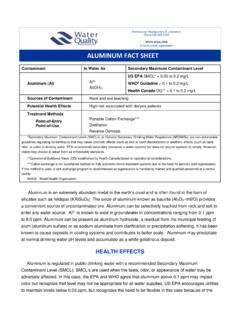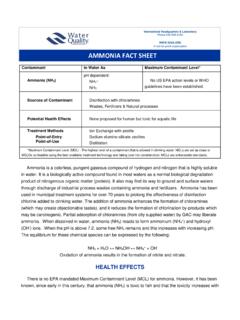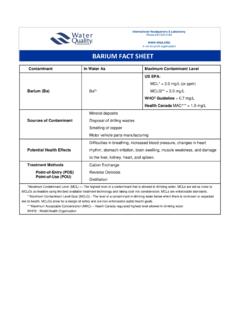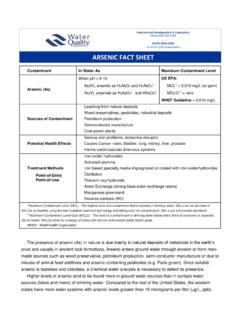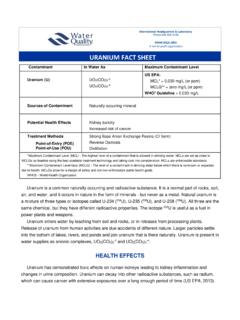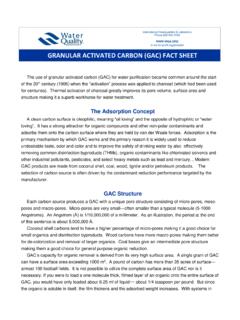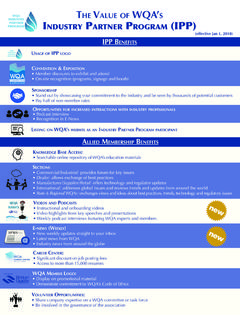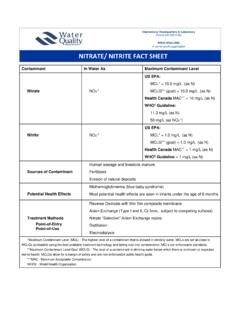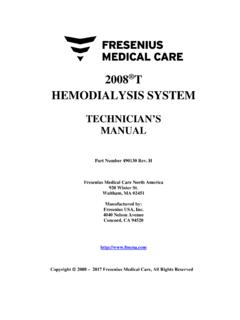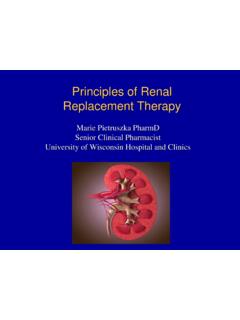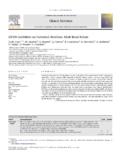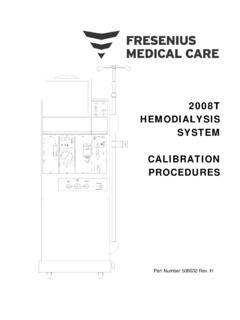Transcription of CHLORAMINE FACT SHEET - Water Quality Association
1 Contaminant In Water As Maximum Residual Disinfectant Level Monochloramine Dichloramine Nitrogen trichloride NH2Cl NHCl2 NCl3 US EPA: MRDL* = mg/L or ppm (measured as Cl2) MRDLG** = mg/L or ppm (measured as Cl2) Sources of Contaminant Municipal Treatment Potential Health Effects Can cause hemolytic anemia when present in dialysis process Water Treatment Methods Point-of-Entry Point-of-Use Activated Carbon Catalytic Activated Carbon *Maximum Residual Disinfectant Level (MRDL) - The highest level of a disinfectant allowed in drinking Water . There is convincing evidence that addition of a disinfectant is necessary for control of microbial contaminants. **Maximum Residual Disinfectant Level Goal (MRDLG) - The level of a drinking Water disinfectant below which there is no known or expected risk to health. MRDLGs do not reflect the benefits of the use of disinfectants to control microbial contaminants.
2 Aqueous chlorine reacts with certain organic materials present in Water sources to form trihalomethanes (THMs). Long-term exposure to these harmful byproducts of disinfection has been linked to an increased risk of cancer and infant birth delivery problems. It is estimated that THMs in drinking Water are responsible for as many as 2-17 percent of the bladder cancers diagnosed each year in the United States. To protect the public, the Environmental Protection Agency has established a maximum contaminant level of milligrams per liter (mg/L) for THMs. To conform to these regulations, many municipal Water supplies have switched to an alternative method of disinfection using chloramination; more than 1 in 5 Americans uses drinking Water treated with chloramines. Chloramination involves the addition of anhydrous or aqueous ammonia (NH3) before or after the addition of chlorine (HOCl) to produce monochloramine (NH2Cl).
3 This reaction is as follows: NH3 + HOCl = NH2Cl + H2O Chloramines also form to a lesser extent during conventional chlorine treatment when aqueous chlorine reacts with natural organic nitrogen. Monochloramine is 200 times less effective as a disinfectant than chlorine, but is an attractive alternative since it does not react as readily with organic CHLORAMINE FACT SHEET International Headquarters & Laboratory Phone 630 505 0160 A not-for-profit organization WQA Technical Fact SHEET : CHLORAMINE materials to form THMs. Many Water utilities overcome the decreased efficiency of monochloramine by dosing first with chlorine, then adding ammonia at a later stage of treatment. Since the initial application is of chlorine, this increases the initial biocidal efficiency of the disinfection but also increases the risk of THM formation during this initial treatment.
4 The ammonia addition results in the residual chemical in the plumbing being monochloramine, with longer lasting residual and reduced risk of THM formation in the distribution system. The process of chloramination is both pH and concentration dependent. Water pH levels below or chlorine to ammonia weight ratios exceeding 5:1 increase the formation of dichloramine (NHCl2) and nitrogen trichloride (NCl3). Dichloramine and nitrogen trichloride are undesirable byproducts in that while they are more effective disinfectants, they are less stable and cause greater swimming pool - type taste and odor problems when they exceed concentrations of mg/L and mg/L (respectively). Excessive chlorine levels produce THMs, while excess ammonia increases the potential for nitrification in the distribution system. The US EPA recognizes three analytical methods as acceptable for measuring residual chloramines.
5 These methods are: Amperometric Titration (Standard Method 4500-C1 D and ASTM Method D 1253-86) DPD Ferrous Titrimetric (Standard Method 4500-C1 F) DPD Colorimetric (Standard Method 4500-C1 G) The average municipal Water system maintains residual monochloramine concentrations around 2 mg/L (range: mg/L to mg/L). Chloramination also has the added benefit of decreasing the formation of biofilms in Water supply systems since the residual levels of monochloramine remain relatively constant throughout the system HEALTH EFFECTS Although the use of chloramination has recently increased, it has a long history of safe and effective use in the United States. The City of Denver, Colorado has utilized chloramination since 1918. An extensive risk assessment by the EPA s National Center for Environmental Assessment (NCEA) utilized existing human and animal studies to conclude that human health effect do not appear to be associated with levels of residual chloramines typically found in drinking Water .
6 However, a Maximum Residual Disinfectant Level Goal (MRDLG) and Maximum Residual Disinfectant Level (MRDL) of mg/L was established by US EPA as the enforceable maximum safety level for chloramines (measured as chlorine, Cl2) for public Water systems under the Safe Drinking Water Act, and the level below which there is no known or expected risk to health. Chloramines do pose a risk for hemodialysis patients and fish. Chloramines easily enter the bloodstream through dialysis membranes and the gills of fish. Once in the blood stream, chloramines denature hemoglobin and cause hemolytic anemia. Accidental use of CHLORAMINE treated Water for dialysis has been responsible for a number of patients requiring transfusion to treat resultant hemolytic anemia, and was a possible factor in an increased mortality (death) rate among the dialysis center WQA Technical Fact SHEET : CHLORAMINE patients during the 5 months after the CHLORAMINE exposure when compared to the 12 months before the CHLORAMINE exposure.
7 Nitrosamines can be generated as byproducts from use of chloramines. They are strongly suspected of being human carcinogens. Nitrosamines can come in contact with most of organs in the body in addition to crossing the placenta. Effects such as cell damage and DNA mutations may occur and lead to cancer even at low levels of exposure. TREATMENT METHODS Residential Point-of-Use Point-of-Entry Activated Carbon Catalytic Activated Carbon Municipal N/A Visit to search for products certified to NSF 42 for CHLORAMINE reduction. While chloramines are not a drinking Water health concern to humans generally, their removal improves the taste and odor of drinking Water . Chloramines are small, stable molecules with no net charge making them difficult to remove by distillation, reverse osmosis, and ion exchange resins. Due to the reaction of aqueous chlorine with organic nitrogen, chloramines also present a concern for municipal Water systems utilizing chlorine as a method of disinfection.
8 This reaction is of concern because there is potential for harmful disinfection byproducts to be produced from it. The most effective nonchemical method for removing chloramines is by activated carbon (C*). Activated carbon does not adsorb chloramines but rather removes them through its ability to act as a catalyst for the chemical breakdown of chloramines to innocuous chlorides in Water . This catalytic reaction involves the formation of an oxide of carbon intermediate (CO*). This reaction is as follows: NH2Cl + H2O + C* = NH3 + Cl- + H+ + CO* 2NH2Cl + CO*= N2 + 2Cl- + 2H+ + H2O + C* Fine mesh sizes of activated carbon remove chloramines more efficiently since they have greater surface areas and allow faster access to catalytic sites. Also, activated carbon that has been acclimated to achieve increased sites for oxide of carbon intermediate (CO*) formation improves CHLORAMINE removal.
9 For new activated carbon, initial dosing with chlorine to preoxidize the carbon may result in more effective CHLORAMINE removal, as shown in the second reaction above. A bed contact time of 10 minutes or greater can be required for complete catalysis of chloramines with traditional activated carbons. New types of activated carbons have been developed with increased catalytic activity that is especially effective at the removal of chloramines. These catalytic carbons may be marketed with a peroxide number (rate of hydrogen peroxide decomposition) in addition to the traditional iodine adsorption number. The CHLORAMINE removal capacity of activated carbon is dependent upon pH. Catalytic carbons have demonstrated increased CHLORAMINE removal efficiency at higher pHs. Ammonia (NH3), chloride (Cl-), and nitrogen gas (N2) are produced by the catalysis of monochloramine.
10 The removal of these catalytic byproducts can be achieved by additional treatment with ion exchange resins or by reverse osmosis. The treatment methods listed herein are generally recognized as techniques that can effectively reduce the listed contaminants sufficiently to meet or exceed the relevant MCL. However, this list does not reflect the fact that point-of-use/point-of-entry (POU/POE) devices and systems currently on the market may differ widely in their effectiveness in treating specific contaminants, and performance may vary from application to application. Therefore, selection of a particular device or system for health contaminant reduction should be made only after careful investigation of its performance capabilities based on results from competent equipment validation testing for the specific contaminant to be reduced. As part of point-of-entry treatment system installation procedures, system performance characteristics should be verified by tests conducted under established test procedures and Water analysis.

